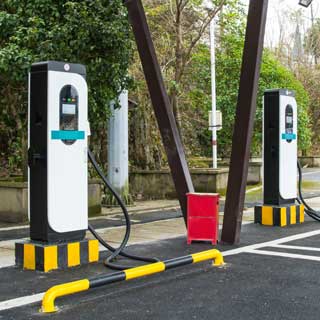Why enroute charging is not the only bet for public e-4W charging facilities

Public charging infrastructure is a key enabler for electric vehicle adoption. To create a competitive, scalable market for setting up public EV charging facilities in India, the Ministry of Power has delicensed EV charging infrastructure. This has opened the sector to a wide range of players who can now invest in the development of charging infrastructure without having a prior licence to do so.
To set up charging infrastructure, location plays a key role and based on the location there can be three types of public charging facilities
- Enroute public charging facilities are similar to regular road side petrol pumps. They are popular alternative for EV drivers without reliable home and office charging options.
- Charging facilities at public parking spaces such as parking lots of malls, business districts, hospitals, schools, community halls, etc. They can be on-street parking spaces along the side of roads, or off-street parking spaces are exclusively allocated parking away from the roads.
- Charging facilities in office premises where both private vehicles and staff transport fleet can charge
Finding a suitable site for a charging station
The selection of a site for charging is a complex problem. There’s a need for a method to objectively gauge the suitability of the location for setting up charging facilities. Such an approach would be useful to compare and select suitable locations within a 3 km x 3 km grid in a city, as provision of at least one charging station within each grid is strongly recommended by the Ministry of Power (Ministry of Power, 2019). The AEEE research team studied the locating criteria that are critical for site selection public e-4W charging facilities. There are two major steps to find a feasible location for deploying charging facilities.
- Step 1: Estimate charging demand potential: It is critical to understand whether an identified location has the potential to attract vehicular traffic and, thereby, charging demand.
- Step 2: Check for Infrastructure availability: The potential locations then have to be assessed based on the availability of requisite supporting land and electrical infrastructure.
How to locate an enroute charging facility
There are four questions to be answered in sequence as shown in figure 1 to select an ideal location for an enroute charging facility. Naturally just like petrol pumps located near main roads, the road hierarchy matters to siting of charging facilities. There is a direct linkage between traffic volume and potential charging demand. It makes sense to ensure that charging facilities are located nearby traffic intersections. The visibility of the location from the adjoining roads is also an important factor which is linked to charging demand.
 Figure 1: Selection of site for an enroute charging station
Figure 1: Selection of site for an enroute charging station
Infrastructure required to establish an e-4W charging facility can be divided into two broad categories: electrical connections and land. In the case of electrical connections, the closer the location is to a distribution equipment, the lesser is the cost of getting and electric connection. It is also important to ensure reliable power supply in the area, and a site with lesser number of power outages. Availability of adequate space and cost of land are important criteria related to land. Once availability of sufficient space is ensured at a location, the circle rate, which is the proxy to market price of the land, is the criteria to choose a good location.
How to locate a charging facility at parking
A different set of parameters are required to locate a charging facility at an off-street parking site. In this case the space hierarchy of the location is important than the road hierarchy. The parking space located in the centre of a business district can attract more charging potential than one parking space at a neighbourhood shop. As shown in Figure 2, in the first step is to look at the capacity utilisation of the parking location. To begin an estimation of the parking turnover ratio. High usage of a parking area is desirable, and the proximity of a location to a transit node would potentially attract more traffic. In the second step, as land for parking is already available, the area for installing chargers should be evaluated. There is no change in the criteria needed to ensure electrical connections. In case a charger is need to be installed in an on-street parking facility, the nearest electrical infrastructure could be a distribution pole or board.
 Figure 2: Selection of site for an off-street charging facility
Figure 2: Selection of site for an off-street charging facility
How to locate a charging facility in an office
In the case of charging facilities within office premises, the locating approach is quite different (refer to Figure 3). First, for the comparison of charging demand potential between different locations, evaluation of the parking turnover ratio and the number of employees availing cab services is required.
A high turnover ratio and high usage of cab services indicate higher potential charging demand at a location. Since it is likely that the premises would have existing electrical connections, instead of determining the site’s proximity to the distribution network, the sanctioned loads at the locations need to be checked, followed by assessment of the existing loading of the connections
 Figure 3: Selection of site for charging at office premises
Figure 3: Selection of site for charging at office premises
Fleets preferences impact viability of charging facility
Indian cities are experiencing an increase in the share of 4-wheeler (4-W) commercial fleet in both passenger and goods transport. The running cost of an Electric Vehicle (EV) on a per kilometer basis being lower than that of an equivalent Internal Combustion Engine (ICE) vehicle, makes a strong driver for adoption of EVs in commercial 4-W fleet. A good strategy for charging is critical to smooth operation of fleets. The 4-W fleet operators can choose between the enroute charging facilities, charging facilities within office premises and charging facilities at public parking spaces. The relative preferences of fleet operators are presented in Figure 4, show that every fleet operator has a distinct preference.
 Figure 4: Relative preferences for fleet operators
Figure 4: Relative preferences for fleet operators
AEEE research surveyed the charging service providers to understand their preferences. As shown in Figure 3, the charging service providers express almost the same level of preference for establishing charging stations at public parking spaces, within office premises, and at logistics hubs. Setting up enroute public charging facilities is found to be the least preferable option, which could be attributed to the difficulty in finding space, along with the high expected cost of land rental in a city. Possible low capacity utilisation of chargers at enroute facilities could also be a reason behind the limited interest of charging service providers in this option.
It is interesting to draw a contrast between charging service providers’ thinking and the preference of fleet operators. However, understanding the customer-choice is critical for any business. It is, therefore, crucial for the charging business to appreciate the preference of e-4W fleet operators.
 Figure 5: Relative preference of charging service providers
Figure 5: Relative preference of charging service providers
For more details please refer to Charging India’s Four Wheeler Transport
Written by Arun Kumar Marndi, Senior Research Associate, Power Utility and Electric Mobility Vertical
Co-author: Chandana Sasidharan, Senior Research Associate, Power Utility and Electric Mobility Vertical




